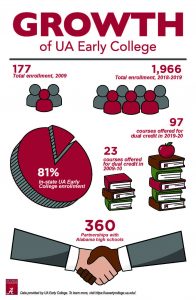 TUSCALOOSA, Ala. — As thousands of freshmen begin classes at The University of Alabama, several hundred have already achieved nearly a semester’s worth of credit hours.
TUSCALOOSA, Ala. — As thousands of freshmen begin classes at The University of Alabama, several hundred have already achieved nearly a semester’s worth of credit hours.
Of those, some have up to 30 credit hours. These UA Early College students, initiated into the rigors of college and the convenience of online learning systems, can graduate from UA in three years or fewer, entering the workforce or graduate school sooner than their peers.
Since 2009, UA Early College has prepared Alabama’s high school students for postsecondary education, providing dual-credit courses on campus and online. UA Early College, which began with 100 students and two full-time teachers, expanded its enrollment to 1,966 students for 2018-19.
UA has also expanded the number of classes that high school students can take for dual-credit.
“The state department is strongly supporting dual enrollment and pushing students and families into any form of college readiness,” said Dr. Victoria Whitfield, director of UA Early College. “This creates amazing opportunities for high school students.”
UA’s dual-credit offerings increased from 23 in 2009 to 97 for the 2019-20 school year. In particular, offerings for arts education and electives have expanded. Anthropology, theater and web design courses are becoming increasingly popular, Whitfield said.
“By 2020, every student in the state of Alabama will be required to take a computer science course,” Whitfield said. “That’s an area we’d like to grow.”
In-state students receive half off tuition during their enrollment, which includes the summer after high school graduation. Students must keep a 2.5 UA GPA to retain the scholarship. More than 80% of enrolled students reside in Alabama and attend one of the 360 high schools that have partnered with UA Early College. The program is expanding its resources and outreach to home-school families.
High school students may begin taking UA Early College classes the summer after ninth grade and must complete advising and a college readiness course to determine further eligibility.
From there, students customize their schedules based on their needs and aspirations. For some, it’s the potential to graduate early; of the UA Early College students that matriculated to UA in fall 2015, 10.5% graduated in three or fewer years. That’s a nearly 6% increase from the 2010 cohort.

For Lauren Dorrill, a UA freshman majoring in general business, UA Early College helped her transition to college and eased the course load burden. Dorrill completed 15 dual-credit courses: English 101 and 102; two government and history courses; and intro to theater.
“I don’t have to take as many hours per semester, which is a huge relief,” Dorrill said. “I have more free time to make connections, meet new people and really work on other classes.”
Its alternative pathway to admission is Early College’s most atypical benefit.
Students can take 17 hours and replace the required ACT score to gain admission, a vital and popular route for students that struggle with standardized testing, Whitfield said.
UA sophomore elementary education major Christlyn Horst, a Chelsea High School graduate, gained priority admission this way. She took UA Early College classes as a high school sophomore, completing the required 17 hours to attend her “dream school.”
“Then I read about admission in a pamphlet and thought, ‘oh, this can be my chance,’” Horst said. “At that point, I thought there was no way for me to get into Alabama. I struggled with standardized tests. I was panicking. I doubted myself. It was a longer road, but I learned so much.”
Horst shares the positive effects UA Early College had on her high school work ethic.
“What you don’t get to tell students a lot is Early College helps with test taking and prepares you for college,” Horst said. “I was not good at completing assignments and managing my time, but if you look at my transcript from high school, after I started taking Early College classes, I became an honors student.”
Contact
David Miller, UA communications, 205-348-0825, david.c.miller@ua.edu
